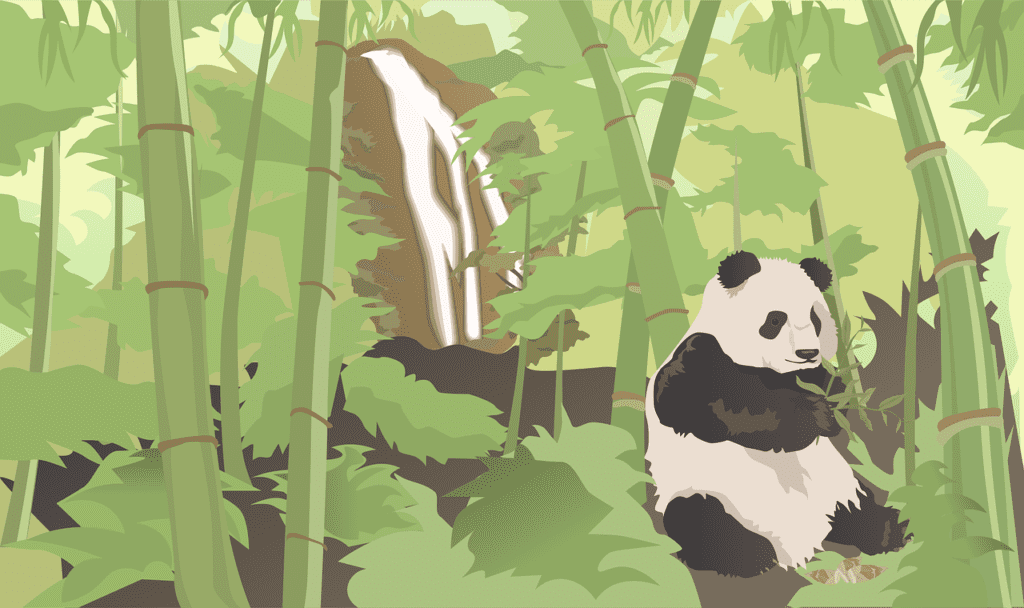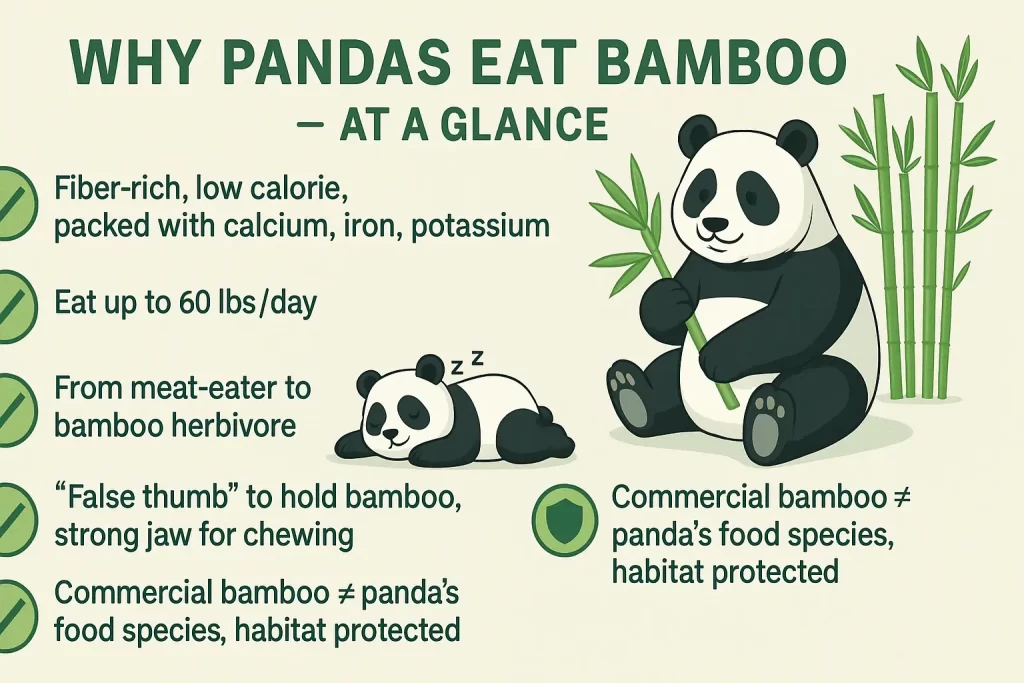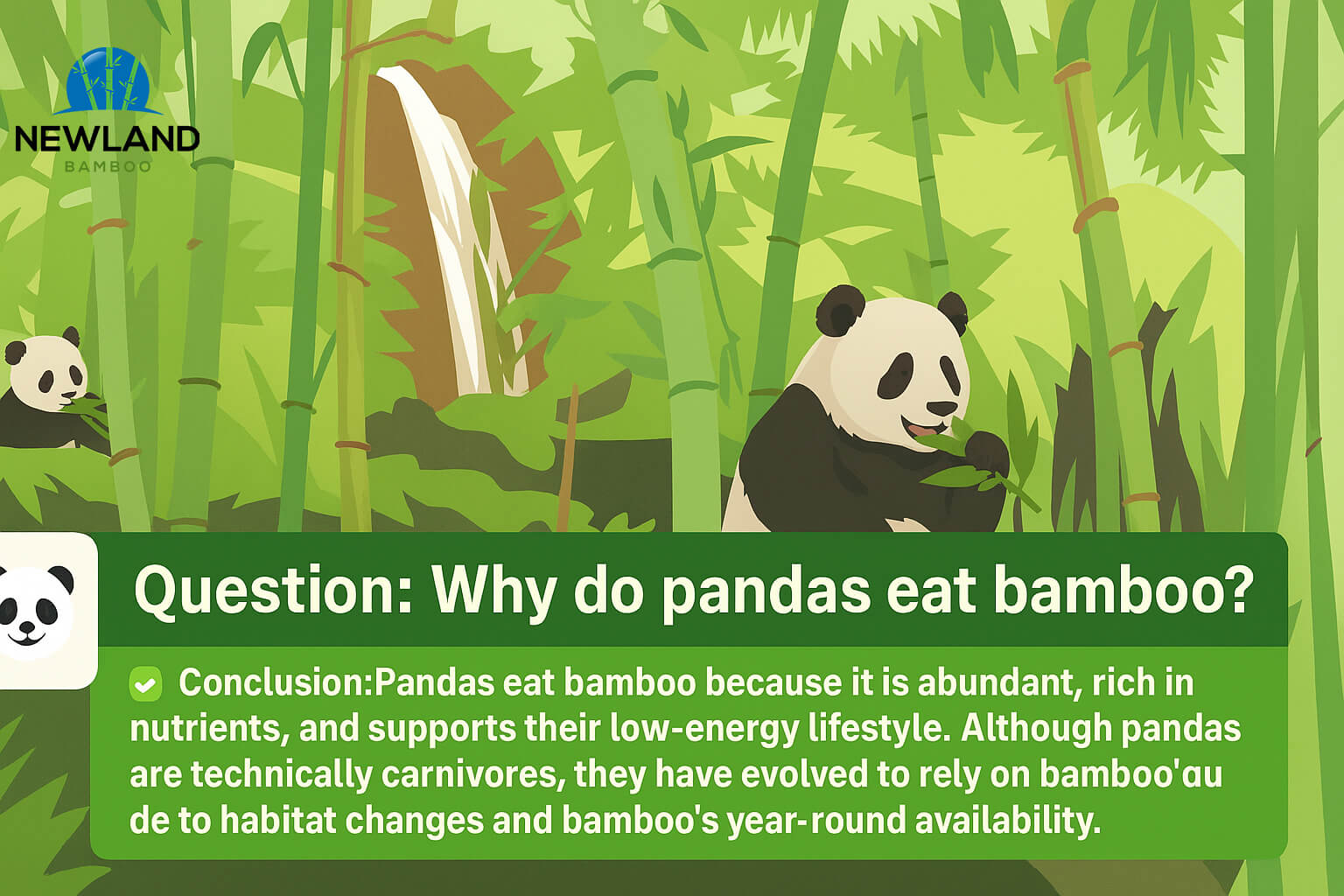Why do pandas eat bamboo?
Pandas eat bamboo because it is abundant, rich in nutrients, and supports their low-energy lifestyle. Although pandas are technically carnivores, they have evolved to rely on bamboo due to habitat changes and bamboo’s year-round availability.

🐼 Introduction: Pandas and Their Unique Diet
Pandas are popular animals found in China and across the world, and one of the unique features of this mammal is its diet. This unique bear species is known to consume vast quantities of bamboo throughout their lifetime. But have you ever wondered why pandas eat bamboo? Whether a diet of bamboo can provide them with the necessary nutrients for survival? Is it the only thing they eat or is there anything else that forms their diet? In this blog post, we will talk about the eating habits of pandas.

What Makes Bamboo the Ideal Food for Pandas?
Bamboo is an excellent food source for pandas because it’s rich in many essential nutrients. It’s low in calories with plenty of fiber, which helps keep the panda’s digestive tract healthy. Moreover, bamboo is rich in protein, vitamins, and minerals, including calcium, iron, and potassium. Pandas use their enlarged wrist bones to grasp bamboo stalks and rip off the leaves, which they munch on for hours on end.
How Much Bamboo Do Pandas Eat Daily?
The panda’s love for bamboo is not just a preference, it’s a necessity. It is estimated that an adult giant panda requires up to 60 pounds of bamboo daily to maintain its health.
Are Pandas Really Carnivores?
While pandas mainly eat bamboo, they are technically classified as carnivores. Interestingly, the panda’s ancestor was a meat-eating animal. But due to the change in climate and bamboo forests spreading across China, pandas started to feed on bamboo. Over time, their digestive system evolved to handle the nutrients in bamboo, and they adapted to a vegetarian diet.
Why Bamboo is a Year-Round Food Source?
One of the main reasons pandas stick to a bamboo diet is that it’s available year-round. Bamboo is not seasonal, so pandas can rely on it for food all year round. Additionally, bamboo grows quickly and abundantly in China, providing ample food sources for pandas. Pandas also do not require much space for their bamboo groves, so their habitat needs are minimal.
Do All Bamboo Species Suit Pandas Equally?
It’s worth noting that not all bamboo species are equal in terms of the nutrients they provide to pandas. Pandas have been observed to prefer certain species of bamboo with higher protein, fat, and sugar content. Such bamboo species include arrow bamboo, black bamboo, and water bamboo, which are abundant in their natural habitats.

Why Do Pandas Eat So Much Bamboo?
But why do pandas eat so much bamboo? This is due to their digestive system. Their gut lacks the necessary microbes to break down plant cellulose efficiently, pandas can only absorb about 20% of the nutrients from the bamboo they consume. This means they must eat constantly to get the nutrients they need, and spend up to 16 hours a day searching for and consuming bamboo.
Pandas’ Low-Energy Lifestyle and Its Impact
Pandas have a low-energy lifestyle and require a significant amount of food to meet their energy needs. Pandas are mostly inactive, sleeping for 10–16 hours per day and expending minimal energy while awake. Consequently, consuming large amounts of bamboo allows pandas to meet their energy requirements without the need for excessive movement. Although bamboo has low-caloric value, it is highly nutritious and easily digestible. Therefore, eating a lot of bamboo is very important to the health of pandas.
Do Pandas Eat Other Foods Besides Bamboo?
Is bamboo the only food pandas eat? In the popular imagination, pandas are often depicted munching on bamboo shoots, which has led many to believe that bamboo is the only food these animals consume. However, while bamboo may constitute the bulk of their diet, pandas are actually omnivores that consume a wide range of foods to meet their nutritional needs.
How Are Pandas Biologically Adapted to Bamboo?
In captivity, pandas are often fed a diet that includes apples, carrots, and special biscuits made from grains and vegetables. This variety in their diet is important to ensure that pandas get all the nutrients they need to stay healthy. Their diet in the wild also includes small animals, including rodents and insects. Although foraging for these food sources is uncommon, it’s not rare. In fact, their diet is made up of over 99% bamboo.
One interesting fact about pandas and their diet is that they have a special adaptation that allows them to digest bamboo. Pandas have an enlarged and muscular forearm that is used to hold and manipulate bamboo stems, as well as a unique jaw that stimulates the tough fibers in bamboo. Additionally, pandas have a unique digestive system that includes an enlarged gut and a special bacteria that helps break down tough plant material.

Bamboo’s Role in Panda Habitat and Ecology
Aside from being the panda’s main source of food, bamboo also plays a crucial role in maintaining the animal’s habitat. Bamboo is an integral part of the forest ecosystem, providing food and shelter to a variety of species, from deer and birds to insects and fungi. Bamboo forests also help to prevent soil erosion, and bamboo roots can help stabilize steep slopes and riverbanks. Bamboo is also used in many industries, from construction to textiles and even household tissue paper. The versatility and sustainability of bamboo make it a valuable resource for both humans and animals alike.
Does Bamboo Commercial Use Affect Pandas?
As bamboo forms a significant part of the giant panda’s diet, there is a valid concern that the practice of utilizing bamboo for commercial purposes may negatively impact the living habitat of these animals.
In fact, the vast majority of pandas live in designated protected areas, and any commercial activity would need to meet strict regulations and guidelines in order to be approved. In addition, bamboo for legal and compliant commercial purposes is not a food source for giant pandas. We don’t have to worry that bamboo production will have a negative impact on giant pandas.
Final Conclusion: Do Pandas Eat Bamboo?
So, in conclusion, pandas do eat bamboo for most of their diet, and this is due to their evolution and adaptation to their surroundings. While they occasionally eat other foods, their digestive system is best suited to handle a bamboo diet, which meets their energy needs. Next time you see a panda munching on bamboo, you can be sure that they are getting the necessary nutrients and energy needed for their survival. Now you know everything about pandas and bamboo!
FAQ Section
질문: 판다는 대나무만 먹나요?
A: 아니요, 대나무가 식단의 99%를 차지하지만 과일, 작은 동물, 특별히 만든 비스킷도 포로 상태에서 먹습니다.
질문: 판다는 왜 대나무를 그렇게 많이 먹나요?
A: 대나무의 장은 대나무에서 최대 20%의 영양소만 흡수할 수 있기 때문에 에너지 필요량을 충족하려면 더 많이 먹어야 합니다.
질문: 대나무는 판다에게 좋은가요?
A: 네, 대나무는 섬유질, 단백질, 미네랄이 풍부하여 판다의 건강과 소화에 이상적인 식품입니다.
Q: 상업용 대나무 제품이 팬더의 먹이 공급에 영향을 주나요?
A: 아니요. 상업용 티슈에 사용되는 대나무는 판다가 먹는 종류가 아니며 엄격한 규정에 따라 생산됩니다.




